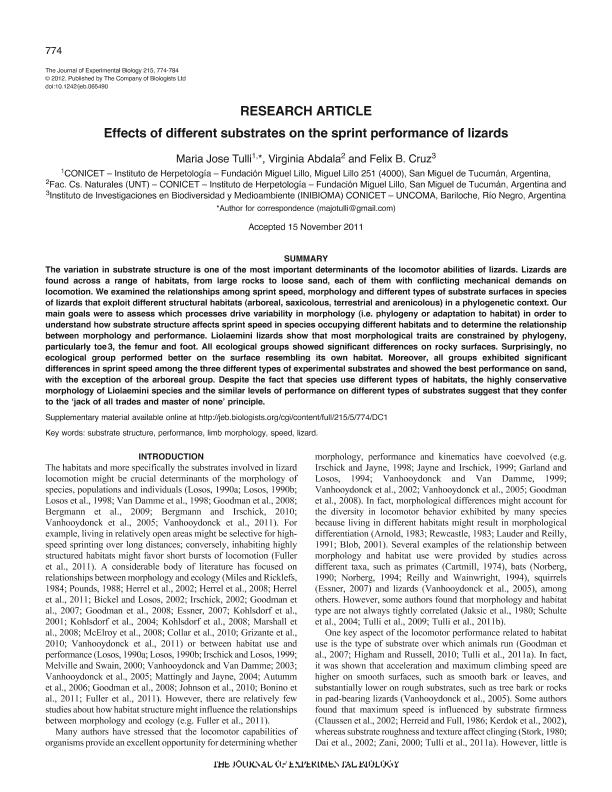Mostrar el registro sencillo del ítem
dc.contributor.author
Tulli, María José

dc.contributor.author
Abdala, Virginia Sara Luz

dc.contributor.author
Cruz, Felix Benjamin

dc.date.available
2019-05-28T14:35:25Z
dc.date.issued
2012-02
dc.identifier.citation
Tulli, María José; Abdala, Virginia Sara Luz; Cruz, Felix Benjamin; Effects of different substrates on the sprint performance of lizards; Company of Biologists; Journal of Experimental Biology; 215; 2-2012; 774-784
dc.identifier.issn
0022-0949
dc.identifier.uri
http://hdl.handle.net/11336/77311
dc.description.abstract
The variation in substrate structure is one of the most important determinants of the locomotor abilities in lizards. Lizards are found across a gradient of habitats from large rocks to loose sand, each of them with conflicting mechanical demands on locomotion. We examined the relationship among sprint speed, morphology and different types of substrate surfaces in species of lizards that exploit different structural habitats (arboreal, saxicolous, terrestrial and arenicolous) in a phylogenetic context. Our main goals were to asses which processes drive variability in morphology (i.e. phylogeny or adaptation to habitat) to understand how substrate structure affects sprint speed in species occupying different habitats, and to understand the relationship between morphology and performance. Liolaemini lizards show that most morphological traits are constrained by phylogeny, particularly toe 3, femur, and foot. All ecological groups showed significant differences on rocky surfaces. Surprisingly, no ecological group performed better on the surface resembling its own habitat. Moreover, all groups exhibited significant differences in sprint speed among the three different types of experimental substrates and showed the best performance on sand with the exception of the arboreal group. Despite the fact that species use different types of habitats, the highly conservative morphology of Liolaemini species and the similar levels of performance on different types of substrates suggests that they confer to the ?jack of all trades and master of none? principle.
dc.format
application/pdf
dc.language.iso
eng
dc.publisher
Company of Biologists

dc.rights
info:eu-repo/semantics/openAccess
dc.rights.uri
https://creativecommons.org/licenses/by-nc-sa/2.5/ar/
dc.subject
Substrate Structure
dc.subject
Performance
dc.subject
Limb Morphology
dc.subject
Speed
dc.subject
Lizards
dc.title
Effects of different substrates on the sprint performance of lizards
dc.type
info:eu-repo/semantics/article
dc.type
info:ar-repo/semantics/artículo
dc.type
info:eu-repo/semantics/publishedVersion
dc.date.updated
2019-05-23T14:51:30Z
dc.journal.volume
215
dc.journal.pagination
774-784
dc.journal.pais
Reino Unido

dc.journal.ciudad
Londres
dc.description.fil
Fil: Tulli, María José. Fundación Miguel Lillo. Dirección de Zoología. Instituto de Herpetología; Argentina. Consejo Nacional de Investigaciones Científicas y Técnicas. Centro Científico Tecnológico - Tucumán. Unidad Ejecutora Lillo; Argentina
dc.description.fil
Fil: Abdala, Virginia Sara Luz. Consejo Nacional de Investigaciones Científicas y Técnicas; Argentina. Consejo Nacional de Investigaciones Científicas y Técnicas. Centro Científico Tecnológico Conicet - Tucuman. Instituto de Biodiversidad Neotropical. Universidad Nacional de Tucuman. Facultad de Ciencias Naturales e Instituto Miguel Lillo. Instituto de Biodiversidad Neotropical. Instituto de Biodiversidad Neotropical; Argentina
dc.description.fil
Fil: Cruz, Felix Benjamin. Universidad Nacional de Tucumán; Argentina. Consejo Nacional de Investigaciones Científicas y Técnicas. Centro Científico Tecnológico Conicet - Patagonia Norte. Instituto de Investigaciones en Biodiversidad y Medioambiente. Universidad Nacional del Comahue. Centro Regional Universidad Bariloche. Instituto de Investigaciones en Biodiversidad y Medioambiente; Argentina
dc.journal.title
Journal of Experimental Biology

dc.relation.alternativeid
info:eu-repo/semantics/altIdentifier/url/http://jeb.biologists.org/content/215/5/774
dc.relation.alternativeid
info:eu-repo/semantics/altIdentifier/doi/https://dx.doi.org/10.1242/jeb.065490
Archivos asociados
